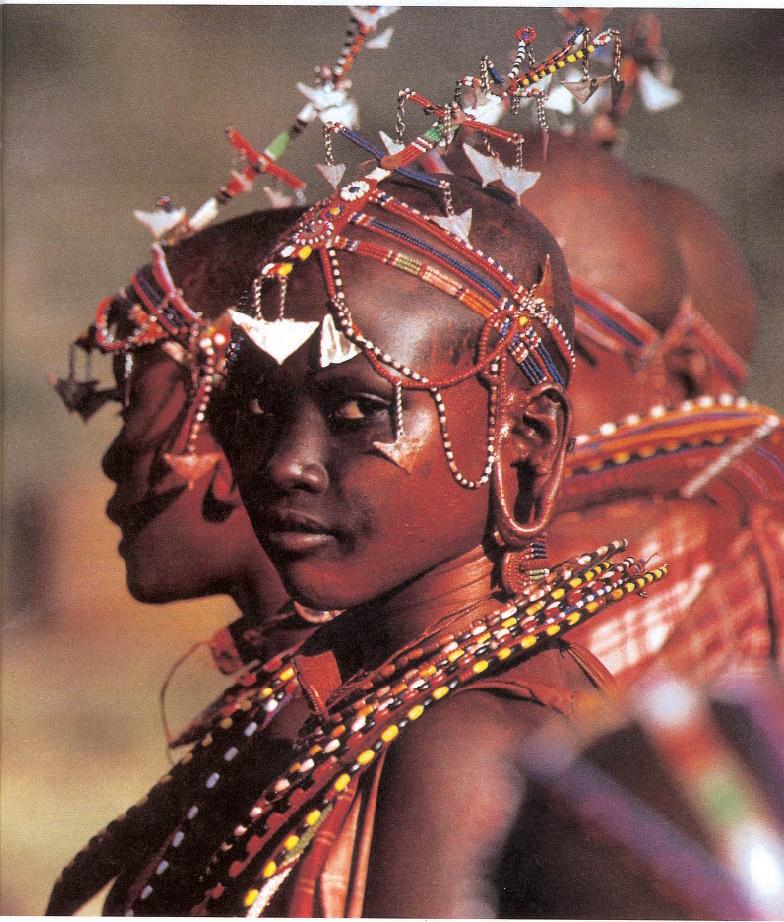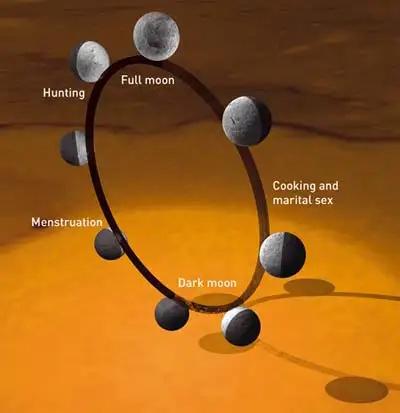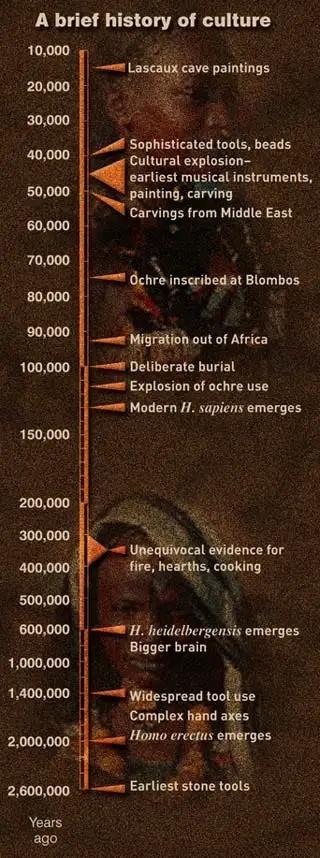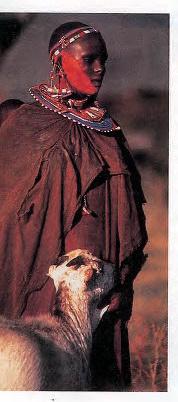Kate Douglas pictures the dawning of human culture
Kate Douglas
Painted Ladies
It all began when women set out to fool their men with a dab of make-up.
Kate Douglas pictures the dawning of human culture
AT FIRST glance it looks like any old lump of pinkish rock. But look closer and you can see it has a cross-hatched pattern carefully etched onto its surface. If someone told you the marks on this piece of red ochre were made by humans more than 70,000 years ago, making it the world’s oldest known work of art, you might well be impressed. But if they told you it was a Stone Age lipstick? You’d probably think they were pulling your leg.
In fact, they’re completely serious. The artefact was found at the Blombos Cave, 30 metres above the sea on the coast of South Africa, and the cave is full of similar lumps of pigment. Many older, undecorated ones have been found throughout Africa. Researchers are using the discovery to paint an extraordinary picture of the emergence of our species, putting cosmetics at the heart of what makes humans unique.
Take this Stone Age make-up, along with fossil evidence and archaeological findings of permanent dwellings, hearths and group living, and you start to see the first signs of an organised society, communicating through signals and symbolism, even rituals. It’s exciting the researchers because they believe this could be the earliest evidence uncovered so far of human symbolic culture-and it may even tell us how culture began.
Anthropologists have never quite agreed on our cultural origins. The objects found alongside the remains of our ancestors so far suggest there was a cultural revolution around 50,000 years ago. That’s when early modern humans started making increasingly intricate bone and stone tools, carving patterns into rocks and creating representational art that reaches its zenith in the spectacular cave paintings at Lascaux in France and other sites. But the Blombos ochre pushes our cultural origins back much further than researchers had suspected, and is leading them to suggest that human culture has a more intriguing history than anyone thought.

To understand where cosmetics come into the story, we have to step back a little. Cultural development is intricately linked to the development of societies. And anthropologists note that we humans have a unique social structure. We are the only primates where males and females form long-term, monogamous relationships within large social groups, with both sexes cooperating to care for the children. If we could only understand how this unusual cooperation came about, it might provide clues to our cultural development.
Leslie Aiello, professor of biological anthropology at University College London, suggests that the need for cooperation was driven by our expanding brains. During the 6 million years of hominid evolution there has been a threefold increase in brain size. That, Aiello points out, would have made a more energy-rich diet essential. A bigger-brained child would have taken many years to nurture to maturity, and our ancestors would have been forced to gradually adopt new strategies to find food, particularly meat. Even with a change in diet, at some point females would have benefited from some help from their menfolk with hunting for food.
Catherine Key, a student of Aiello's, turned to computer modelling to find out what would make males help out. She based her model on a game called the prisoner's dilemma, which explores the conditions under which pairs of players will cooperate. She used the model to discover how altering the costs of reproduction— the amount of energy females invest in rearing their offspring and males expend attracting and keeping mates—could have affected the level of cooperation between the sexes.
The game showed that as costs increase, females will begin to help one another (Folia Primatologica, vol 71, p 77). "That's because females have the same interests, such as food and child care," says Key. But there were few conditions under which males and females would cooperate. While it was to females' advantage to put all their effort into raising a small number of offspring, the best strategy for males was to attempt to father as many offspring as possible and not stick around to watch them grow up. But the model showed that males and females will cooperate when two conditions are met: first, when female reproductive costs are much higher than those of males, and second, if females can somehow punish uncooperative males.
The fossil record holds clues about when these conditions might have existed. The earliest hominids show distinct sexual dimorphism—males were around 50 per cent bigger than females. For males, being big and impressive allows them to win more mates. The trouble is they need more food, and so their reproductive costs are high. But over 4 million' years of evolution, although both sexes got gradually bigger, the size difference was reduced to just 20 per cent. This meant that males were no longer investing much more in their body size than females, and so their reproductive costs would have grown more slowly than females'. Add to that a huge increase in brain size between 500,000 and 100,000 years ago, when cranial capacity expanded from around 1200 to 1500 cubic centimetres, and you get a substantial leap in female reproductive costs relative to male.
The crunch may well have come with a dramatic deterioration in global climate, when meat became increasingly hard to get. "The energetic burdens of females would probably have been most acute during the penultimate glacial, which is 190,000 to 130,000 years ago," says Ian Watts, also from University College London, and one of the team studying ochre at Blombos. This is just the time frame in which our own species, Homo sapiens, evolved.

So, what about the other condition? What strategy might females have devised to punish uncooperative males? One suggestion is that women formed strong coalitions that wielded their power by withholding sex. A successful coalition would have required them to communicate and coordinate their action and send out strong signals to the men, telling them they were fertile but temporarily unavailable. It's a tricky signal to communicate, because signs of fertility would have been a big attraction for the males, yet at the same time the females had to persuade them to go off hunting. They'd have to plan, be devious, and know what the others were doing—all of which would have constituted a form of culture. And that's were the red ochre comes in.
The theory is based on an idea proposed a decade ago by Chris Knight from the University of East London and developed by Camilla Power of University College London. They point out that features of the modern human female reproductive cycle, such as concealed ovulation and continuous sexual receptivity, could have evolved as ways of encouraging males to stick around. But these signals alone wouldn't prevent the strongest males from monopolising females—by noticing menstruation they could systematically identify and target females as they approached the peak of fertility. This would have became a problem as females became increasingly reliant on help to meet the costs of reproduction.
Knight suggested that our female ancestors synchronised their reproductive cycles so that a dominant male simply wouldn't have time to service all the fertile females. This would give more males a chance to procreate and would increase their incentive to stay. But what the women really needed was food so, according to Knight, they formed coalitions and invented collective bargaining, going on "sex strike" at the time of menstruation and continuing to withhold sex until their men brought meat.
In support of his theory, Knight pointed out that traditional societies often have menstruation and hunting rituals that are linked together and coordinated through the phases of the Moon (see Figure, left). Hunting expeditions are more successful if the nights are moonlit, and the human female reproductive cycle, with a mean length of 29.5 days, exactly matches the lunar cycle. Knight highlighted studies suggesting that women do synchronise their periods when they live in close proximity, although the evidence for this is equivocal.
It was Power who realised that women needn't synchronise their cycles to benefit from menstrual coalitions, they just had to fake the signs. She believes that around 500,000 years ago, when brain size started expanding rapidly, menstruating women would have become a threat to other females by attracting much-needed male attention. So women who were nursing and pregnant took control of the situation by feigning menstruation. At first, this "sham menstruation" was improvised and impromptu, perhaps with women borrowing one another's blood or using animal blood. "Then everything becomes symbolically organised rather than ad hoc," she says, "and that would have triggered the regular use of red ochre."
The emergence of "sex strikes" is more difficult to explain. Menstruation is a woman's best advertisement of fertility so, contrary to what most people think today, it is a huge come-on. The problem for female coalitions would have been that rather than attracting their men, they needed to persuade them to leave the camp to hunt. Our ancestors would have had to devise a very powerful cultural "no" signal to counteract the strong biological "yes" that menstruation gives out.
"To say 'no' in the loudest possible way, you don't use words, you do things that are the exact opposite of what you would do if you were going to make 'yes' signals," says Power. "To say 'no', you do the reverse of being a human female—you pretend to be male and you pretend to be an animal."

Combining a come-on with a turn-off may seem a little far-fetched and, of course, there's no turning the clock back 150,000 years to see how our female ancestors behaved. But Power has done the next best thing: she has been studying initiation rituals in sub-Saharan traditional societies, in which such strategies may persist to this day.
Part of a girl's puberty ritual among the Khoisan, for example, is a dance called the Eland Bull Dance, where the girl plays the part of the bull, sending out a "wrong sex, wrong species" signal. Meanwhile, the women of the camp dance around her as if mating with the bull, taunting the local men with their complete lack of interest in them. "The message to the males is absolutely clear—you go off, you hunt some eland, and then we'll see. It's a sex strike in all but name," says Power. The Hadza have a similar ritual called "epeme", linked to symbolic menstruation and the new moon, associated with a mythical heroine who hunts down male zebra and wears their penises.
In a recently completed study, Power found that in a range of traditional societies puberty rituals link menstrual taboos with hunting, lunar phase and "wrong sex" signals in ways that meet the predictions of the sham menstruation and sex strike theory. "It's wildly improbable that any of that is going to be there by accident," she says.
And there is more evidence in the archaeological record, says Watts. His study of 74 sites in southern Africa dating from more than 20,000 years ago reveals an explosion in the use of red ochre and other red pigments between about 100,000 and 120,000 years ago. And, he says, new findings in Zambia and the re-dating of the important Border Cave site in South Africa push the date of the ealiest use back further still—perhaps to 170,000 years ago in Zambia.
Some have yet to be convinced about the symbolic purpose of ochre, especially so early in our history, believing that it might instead have been used to preserve hides. But Watts doesn't buy this. He admits that iron oxides neutralise collagenase, an enzyme used by bacteria to break down fibrous collagen, but studies of Kalahari bushmen suggest hides wear out before they succumb to bacterial decay. And Watts's own research reveals that our ancestors went out of their way to collect high-quality red iron oxides, even when other oxides of different colours were available locally and could have preserved hides just as well. Red ochre has got to be culturally significant, argues Power. "Suddenly people just want to body-paint. Well, why?" she asks. "This is the only Darwinian explanation for why on earth that ochre is there."
Of course, not everyone is convinced, but anthropologists are starting to take the idea seriously. One of its strengths is that it addresses the question of why symbolic culture evolved, rather than simply how it did so, according to Robin Dunbar from the University of Liverpool. He agrees that the dynamics of social groups must have been an important factor.
"Knight's story is a powerful one because it makes a number of very specific claims," says Robert Aunger from Cambridge University. Even so, he has yet to be convinced by the evidence. "It is just one story among many in an area still so ripe with controversy that it will take history a long time to sort out who's right and who's wrong."
Is it frivolous to suggest that cosmetics are the roots of human culture? Power's answer is an emphatic no. She points out that the word "cosmetics" comes from the Greek, "cosmos", meaning order. "In traditional cultures cosmetics are not mere frippery," she says. They define who belongs to which group, who can touch who, and who can mate with who. "The regularised use of cosmetics as a sexual signal could even have been the thing that marked off modern humans." So perhaps lipstick is not just the key to culture, but also to the origin of our species.



